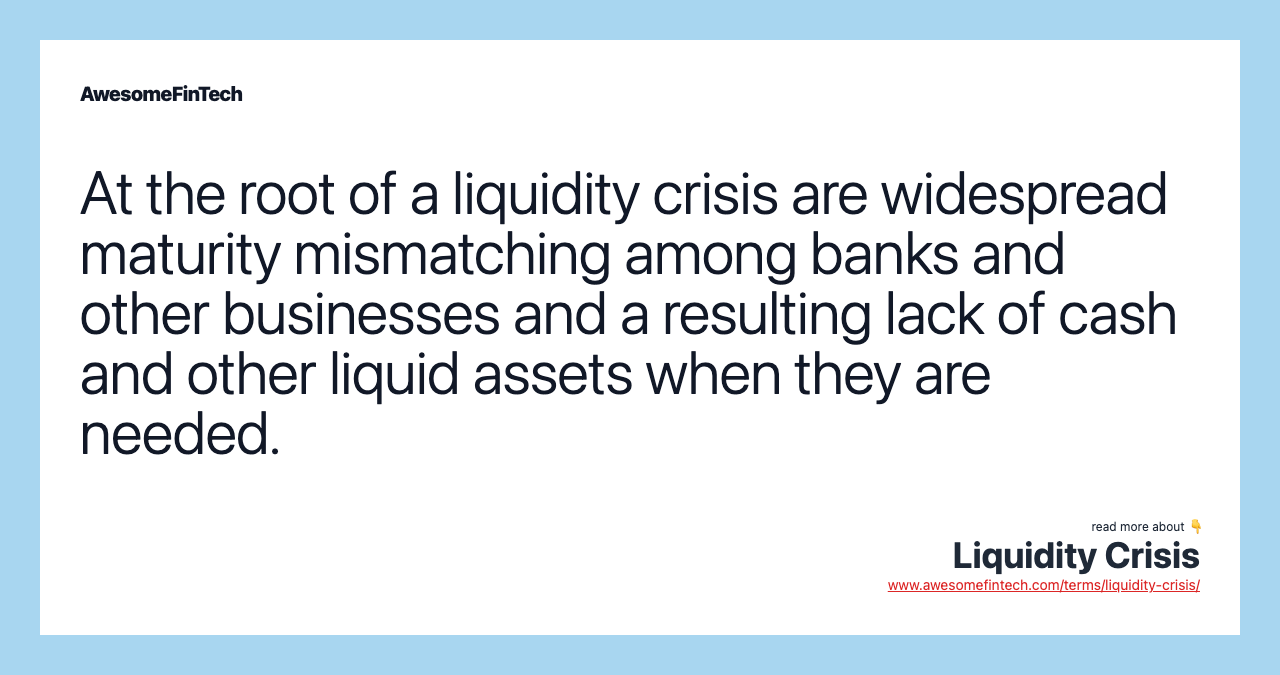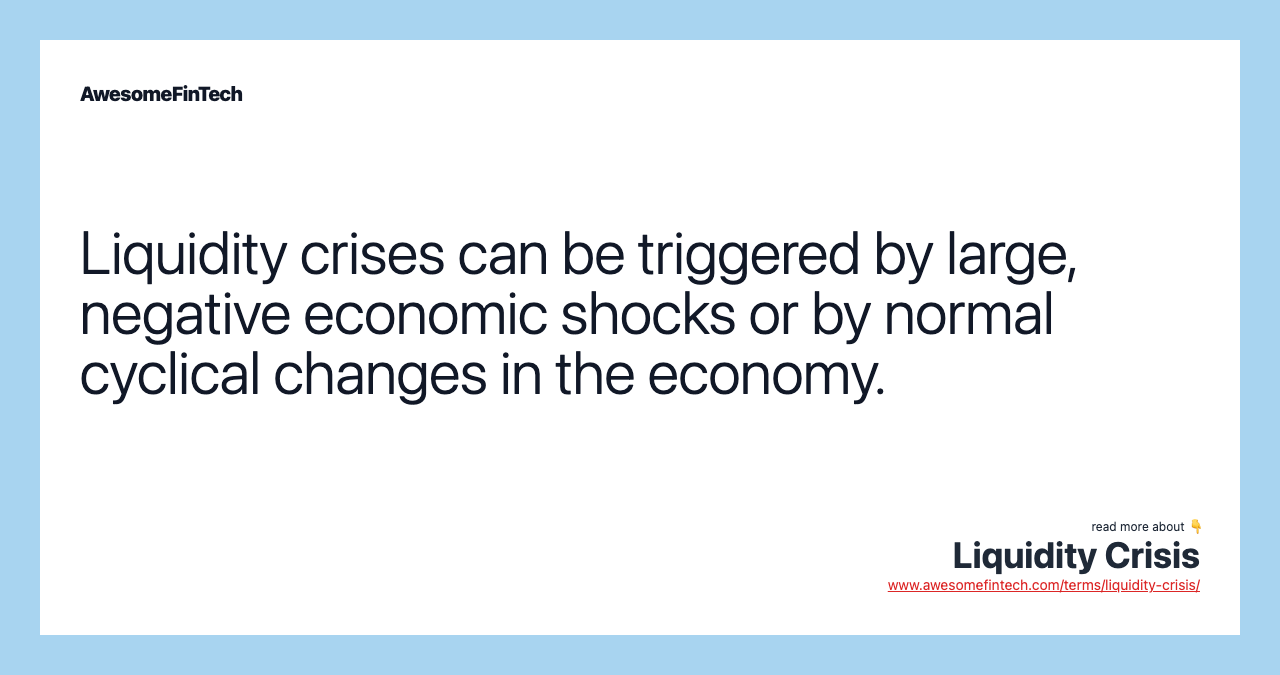Liquidity Crisis
A liquidity crisis is a financial situation characterized by a lack of cash or easily-convertible-to-cash assets on hand across many businesses or financial institutions simultaneously. When many financial institutions experience a simultaneous shortage of liquidity and draw down their self-financed reserves, seek additional short-term debt from credit markets, or try to sell-off assets to generate cash, a liquidity crisis can occur. In a liquidity crisis, liquidity problems at individual institutions lead to an acute increase in demand and decrease in supply of liquidity, and the resulting lack of available liquidity can lead to widespread defaults and even bankruptcies. If a business investments and debt are mismatched in maturity, additional short-term financing is not available, and self-financed reserves are not sufficient, then the business will either need to sell other assets to generate cash, known as liquidating assets, or face default. Maturity mismatching is a normal and inherent part of the business model of most financial institutions, and so they are usually in a continual position of needing to secure funds to meet immediate obligations, either through additional short-term debt, self-financed reserves, or liquidating long-term assets.

More in Economy
What Is a Liquidity Crisis?
A liquidity crisis is a financial situation characterized by a lack of cash or easily-convertible-to-cash assets on hand across many businesses or financial institutions simultaneously.
In a liquidity crisis, liquidity problems at individual institutions lead to an acute increase in demand and decrease in supply of liquidity, and the resulting lack of available liquidity can lead to widespread defaults and even bankruptcies.



Understanding a Liquidity Crisis
Maturity mismatching, between assets and liabilities, as well as a resulting lack of properly timed cash flow, are typically at the root of a liquidity crisis. Liquidity problems can occur at a single institution, but a true liquidity crisis usually refers to a simultaneous lack of liquidity across many institutions or an entire financial system.
Single Business Liquidity Problem
When an otherwise solvent business does not have the liquid assets — in cash or other highly marketable assets — necessary to meet its short-term obligations it faces a liquidity problem. Obligations can include repaying loans, paying its ongoing operational bills, and paying its employees.
These business may have enough value in total assets to meet all these in the long-run, but if it does not have enough cash to pay them as they come due, then it will default and could eventually enter bankruptcy as creditors demand repayment. The root of the problem is usually a mismatch between the maturities of investments the business has made and the liabilities the business has incurred in order to finance its investments.
This produces a cash flow problem, where the anticipated revenue from the business' various projects does not arrive soon enough or in sufficient volume to make payments toward the corresponding financing.
For businesses, this type of cash flow problem can be entirely avoided by the business choosing investment projects whose expected revenue matches the repayment plans for any related financing well enough to avoid any missed payments.
Alternatively, the business can try to match maturities on an ongoing basis by taking on additional short-term debt from lenders or maintaining a sufficient self-financed reserve of liquid assets on hand (in effect relying on equity holders) to make payments as they come due. Many businesses do this by relying on short-term loans to meet business needs. Often this financing is structured for less than a year and can help a company meet payroll and other demands.
If a business investments and debt are mismatched in maturity, additional short-term financing is not available, and self-financed reserves are not sufficient, then the business will either need to sell other assets to generate cash, known as liquidating assets, or face default. When the company faces a shortage of liquidity, and if the liquidity problem cannot not solved by liquidating sufficient assets to meet its obligations, the company must declare bankruptcy.
Banks and financial institutions are particularly vulnerable to these kind of liquidity problems because much of their revenue is generated by lending long-term on loans for home mortgages or capital investments and borrowing short-term from depositors accounts. Maturity mismatching is a normal and inherent part of the business model of most financial institutions, and so they are usually in a continual position of needing to secure funds to meet immediate obligations, either through additional short-term debt, self-financed reserves, or liquidating long-term assets.
Liquidity Crisis
Individual financial institutions are not the only ones who can have a liquidity problem. When many financial institutions experience a simultaneous shortage of liquidity and draw down their self-financed reserves, seek additional short-term debt from credit markets, or try to sell-off assets to generate cash, a liquidity crisis can occur. Interest rates rise, minimum required reserve limits become a binding constraint, and assets fall in value or become unsaleable as everyone tries to sell at once.
The acute need for liquidity across institutions becomes a mutually self-reinforcing positive feedback loop that can spread to impact institutions and businesses that were not initially facing any liquidity problem on their own.
Entire countries — and their economies — can become engulfed in this situation. For the economy as a whole, a liquidity crisis means that the two main sources of liquidity in the economy — banks loans and the commercial paper market — become suddenly scarce. Banks reduce the number of loans they make or stop making loans altogether.
Because so many non-financial companies rely on these loans to meet their short-term obligations, this lack of lending has a ripple effect throughout the economy. In a trickle-down effect, the lack of funds impacts a plethora of companies, which in turn affects individuals employed by those firms.
A liquidity crisis can unfold in in response to a specific economic shock or as a feature of a normal business cycle. For example, during the financial crisis of the Great Recession, many banks and non-bank institutions had significant portions of their cash come from short-term funds that were put towards financing long-term mortgages. When short-term interest rates rose and real estate prices collapsed, such arrangements forced a liquidity crisis.
A negative shock to economic expectations might drive the deposit holders with a bank or banks to make sudden, large withdrawals, if not their entire accounts. This may be due to concerns about the stability of the specific institution or broader economic influences. The account holder may see a need to have cash in hand immediately, perhaps if widespread economic declines are feared. Such activity can leave banks deficient in cash and unable to cover all registered accounts.
Related terms:
Bank Reserves
Bank reserves are the cash minimums financial institutions must retain to meet central bank requirements. Read how bank reserves impact the economy. read more
Business Cycle : How Is It Measured?
The business cycle depicts the increase and decrease in production output of goods and services in an economy. read more
Cash Flow
Cash flow is the net amount of cash and cash equivalents being transferred into and out of a business. read more
Depression
An economic depression is a steep and sustained drop in economic activity featuring high unemployment and negative GDP growth. read more
Discount Rate
"Discount rate" has two distinct definitions. I can refer to the interest rate that the Federal Reserve charges banks for short-term loans, but it's also used in future cash flow analysis. read more
Economic Shock
An economic shock is an event that occurs outside of an economic model that produces a significant change within an economy. read more
The Great Recession
The Great Recession was a sharp decline in economic activity during the late 2000s and was the largest economic downturn since the Great Depression. read more
Liquid Asset
A liquid asset is an asset that can easily be converted into cash within a short amount of time. read more
Liquidity Coverage Ratio (LCR)
Liquidity Coverage Ratio (LCR) is a requirement under Basel III whereby banks are required to hold enough high-quality liquid assets to fund cash outflows for 30 days. read more
Liquidity Ratio
Liquidity ratios are a class of financial metrics used to determine a debtor's ability to pay off current debt obligations without raising external capital. read more